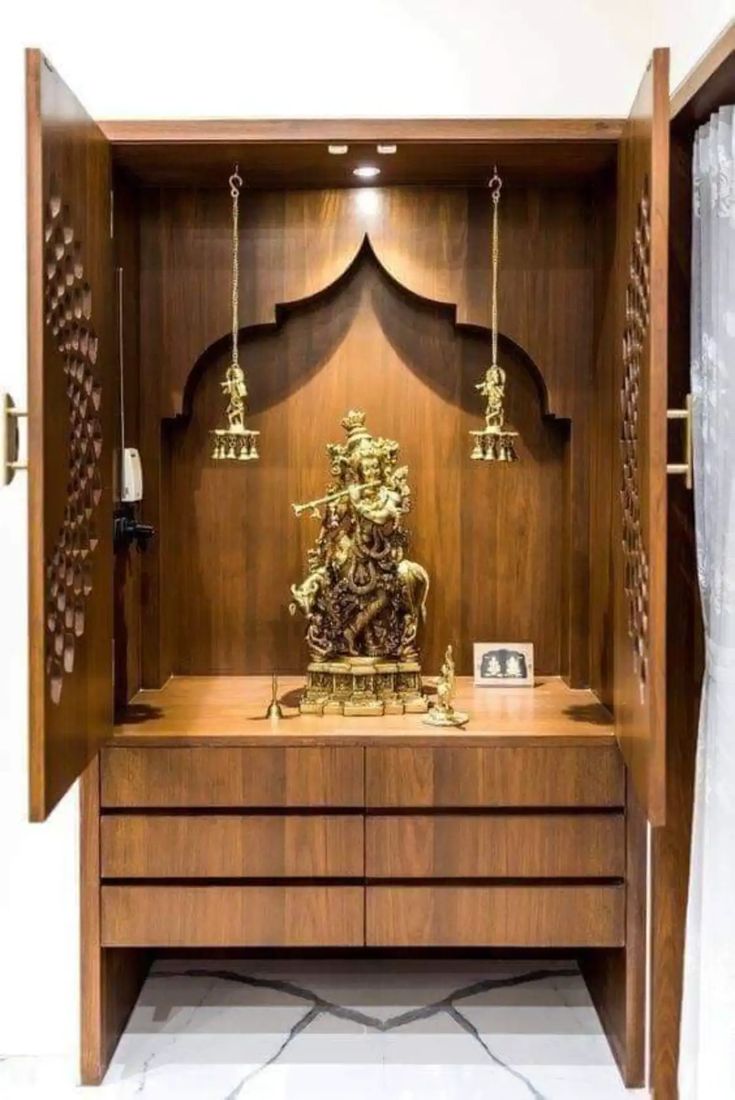Pooja rooms hold a special place in Indian homes, serving as sacred spaces for worship and reflection. The inclusion of doors in these spaces is not merely a practical consideration but is deeply rooted in Vastu principles and cultural symbolism.
In this extensive exploration, we delve into the reasons behind the necessity of doors in pooja rooms, incorporating elements of Vastu, Hindu mythology, and the transformative impact of aesthetically pleasing designs on the overall ambiance of the space.
Enhancing Spiritual Spaces: The Significance and Aesthetics of Pooja Room Doors
According to the principles of pooja room vastu, doors play a pivotal role in maintaining the sanctity of the sacred space. The inclusion of doors and thresholds is believed to act as a barrier against impurities, ensuring that insects and other contaminants are kept out. Vastu Shastra, an ancient Indian architectural science, emphasizes the creation of a harmonious and balanced environment. In the context of pooja rooms, doors contribute to this balance by preventing negative energies from entering the sacred space.
Additionally, the concept of thresholds is significant, as it symbolizes the demarcation between the outer and inner realms. This demarcation not only aligns with vastu principles but also holds spiritual symbolism, signifying the transition from the mundane to the divine. The meticulous adherence to these principles reflects a deep-rooted cultural and spiritual understanding that has been passed down through generations.
Hindu mythology further reinforces the importance of doors in pooja rooms, drawing parallels between the gods and humans. The belief that gods take on human forms suggests a need for privacy during certain rituals. This concept is vividly observed in temples, where after the deity is offered food, the doors to the inner sanctum are closed temporarily. This act symbolizes a moment of privacy for the gods, during which they are believed to partake in the offerings. The ritual of closing the pooja room doors also transforms the offered food into prasad, a blessed and sanctified offering. This practice not only reflects the reverence for the divine but also underscores the symbolic significance of doors in creating a sacred and exclusive space.
Pooja Room Door Designs for Indian Homes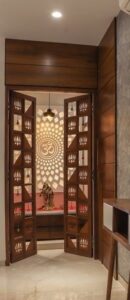
When envisioning a pooja room, the mind often conjures images of finely crafted wooden doors. Wood has been the material of choice for centuries, exuding a timeless and traditional charm. These doors, adorned with intricate carvings and detailing, not only serve as functional barriers but also stand as symbolic gateways to divine spaces. The allure of a classic wooden pooja room door lies in its ability to seamlessly blend traditional aesthetics with modern interior design trends. The warm tones of the wood create a welcoming atmosphere, fostering a sense of serenity within the sacred space. The craftsmanship involved in carving traditional motifs and religious symbols onto the wooden surface adds a touch of artistry, making each door a unique masterpiece.
In contemporary homes where space is often a premium, opting for a wall-mounted mandir with a classic wooden door becomes a practical and aesthetically pleasing solution. By choosing this design, homeowners can maximize floor space while still incorporating the essential elements of a pooja room. The wall-mounted mandir, framed by an intricately designed wooden door, becomes a focal point that draws the eye and captures the essence of the sacred space. This design choice not only adds a touch of elegance to the room but also allows for creative customization. Homeowners can experiment with various sizes and shapes, creating a pooja room that seamlessly integrates with the overall interior design of the home.
Crafting Elegant Pooja Room Door Designs with Plywood and MDF: A Budget-Friendly Alternative to Solid Wood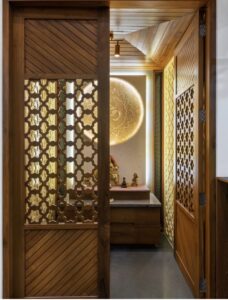
Wooden doors with CNC (Computer Numerical Control) cut panels have become a popular trend in contemporary pooja room designs. These doors combine the warmth of woody tones with the crisp elegance of white, creating a modern and sophisticated look. The intricate patterns and motifs carved through CNC technology add a decorative element, enhancing the spiritual ambiance of the pooja room.
Despite its unique appeal, solid wood comes with a higher price tag and demands regular maintenance. For individuals with busy lifestyles or limited budgets, an alternative solution is necessary. This leads us to the exploration of plywood and MDF as viable materials for crafting cost-effective yet visually appealing pooja room doors. Plywood and MDF offer a versatile canvas for crafting pooja room doors that mimic the beauty of solid wood. These materials can be stained or painted to achieve a mix of woody tones and white, allowing homeowners to customize the design to match their interior aesthetics. The flexibility of plywood and MDF in terms of finishes and colors opens up a world of possibilities, making them ideal choices for those seeking a modern and elegant pooja room door design.
Enhance Your Pooja Room Aesthetics with Unique Jaali Door Designs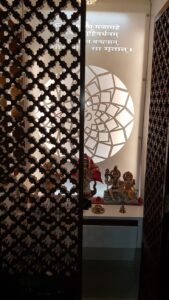
Jaalis have an innate ability to evoke a sense of tradition and timelessness. Whether crafted from wood, acrylic, CNC, or laser-cut MDF, jaalis offer a versatile range of materials to suit different budgets. The intricate patterns and designs carved into the jaali not only enhance the aesthetic beauty of the door but also contribute to the spiritual ambiance of the pooja room.
Ventilation and Airiness: One of the standout features of incorporating jaalis into your pooja room door design is the ability to maintain ventilation and airiness in the space. The perforated patterns allow for the free flow of air, preventing the pooja room from feeling enclosed. This is especially beneficial during religious ceremonies or daily rituals, ensuring a comfortable and well-ventilated environment.
Partial Visibility for Added Convenience: Another notable advantage of jaali doors is the partial visibility they offer into the pooja room. This feature allows inhabitants to keep an eye on the room even when the door is closed. For instance, if a diya is burning inside, one can easily check on it without having to open the door. This not only adds convenience but also addresses safety concerns, providing peace of mind to homeowners.
New-Age Pooja Room Glass Door Designs
Modern pooja room door designs have evolved significantly over time, with glass emerging as a novel and popular choice for contemporary homes. Unlike traditional materials, the transparency of glass allows for a unique blend of aesthetics and functionality in pooja room door designs.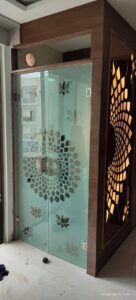
One of the notable features of glass doors for pooja rooms is their ability to provide constant visibility. Opting for plain glass doors ensures that the sanctity of the pooja room is always on display. This transparent approach creates a connection between the spiritual space and the rest of the home. For those who appreciate a balance between openness and privacy, a combination of glass and wood can be employed to craft a distinctive door design that complements modern interiors. To enhance the visual appeal of pooja room doors, homeowners can explore different types of glass. Plain glass offers unobstructed views into the mandir, creating a sense of continuity within the living space. However, for those who prefer a level of seclusion, options like reeded, fluted, or frosted glass provide a more opaque finish, adding an element of mystery to the sacred area.
Conclusion: In summary, the inclusion of doors in pooja rooms transcends mere practicality; it is deeply embedded in Vastu principles, Hindu mythology, and cultural symbolism. The choice of wooden designs, with their Vastu compliance and traditional aesthetic appeal, further enriches the spiritual experience. By exploring various door designs, incorporating brass bells, and embracing modern interpretations, homeowners can create pooja rooms that are not only functional but also visually captivating and spiritually uplifting.
